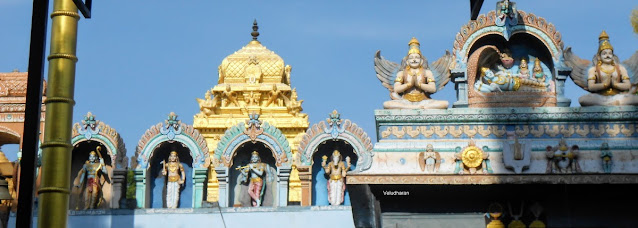வஞ்சித்துறைபுராதனர் பூதிதேகர்சரோருகர் மாற்குமரியர்நிராமய நீடிருப்பார்ஒரேகடத் தீசராமேThe
visit to this Sri Vadamalleeswarar Temple at Oragadam near Thirukalukundram in
Chengalpattu District was a part of Maha
Vishnu and Shiva Temples visit at Singaperumalkoil, Kolathur ( Appur, Vembakkam
), Mettu Pudupakkam and Pon Vilaintha
Kalathur, on 24th October 2021.
Moolavar : Sri Vadamalleeswarar Consort : Sri Amirthavalleeswari
Some
of the salient features of this temple are….The
temple is facing east on a small Hill with nearly 100 steps to climb up. The
entrance to the temple from west side. Lord Shiva in meditation posture is on a
small rock A small deepasthambam, balipeedam and Rishabam / Idabam are in-front
of the temple. Moolavar in the sanctum sanctorum looks cute in alangaram. In
Koshtam, Nirai Vinayagar, Dakshinamurthy, Maha Vishnu, Brahma and Durgai. In
the makara thoranam above the Koshtams, the bas reliefs of Vinayagar, Dakshinamurthy,
Brahma and Durgai with her Vahana Lion / Simham. The Koshta images are
installed at a latter date. Vinayagar and Murugan are at the entrance of ardha
mandapam.
Lord
Shiva’s stucco image, Ambal Sannidhi, Nalvar, Chandikeswarar, Suriyan and
Chandran are in the praharam. Ambal is in a separate Temple like sannidhi
facing east on the north of the main temple.
Ambal’s images are in the Koshta niches.
ARCHITECTUREThe
temple was constructed with Gajabirushta Vimana style. The Adhistana is of
simple padabandha adhistana on a Lotus
petals pedestal as upana. The Adhistana consists of jagathy, Threepatta kumuda
and Pattigai. The walls starts with vedigai and the walls are supported by
Vishnukantha pilasters with Veetu pothiyal. The Prastaram consists of Valabi,
kapotham and vyalavari. Lotus petals are in the valabi. The Kapotam has the nasikudus
with various images. An ekathala Gajabirushta Vimana with three kalasas is on
the sanctum sanctorum. A Temple structure with Lord Shiva is in the lalada
Nasi. Stucco images of Natarajar with Sivakami, Vinayagar and Dakshinamurthy
are in the South side Greeva koshtam, Maha Vishnu is in the West side Koshtam
and Brahma, Saraswati and Sri Valli Devasena Subramaniyar are in the north side
greeva koshtam.
The
front mandapam was built during
Vijayanagara Period. Subramaniyar, Vinayagar, Nandhiyam peruman, Maharishis,
Donors of this Mandapam, Sanganidhi,
Krishna with Yasodha, Maha Vishnu as Varahamurthy, Herder, sculptures are on the mandapam pillars. At
the entrance both side Columns of the ardha mandapam has the bas reliefs
of Vyagrapadar, a King ( May be Chozha
), Ambal as Cow worshiping Lord Shiva, Ayyanar, Vinayagar and Murugan
A
Lotus medallion is at the centre of the ceiling. In addition to that two
lizards are also carved. Stucco image of Lord Shiva with Parvati as
Rishabaroodar is on the top of the Mukha mandapam.
HISTORY AND
INSCRIPTIONSThe
original Gajabirushta Vimana style temple
was constructed during 7th Century Pallava King Nandivarman-II, Period and latter reconstructed as a stone temple during
Chozha period, between 10th to 12th Century. Rajarajan-I and Rajendra-I's period inscriptions are much damaged.
The
Pallavamalla’s 7th reign year ( 731 - 796 CE ) inscription found on the rock is much
damaged. This inscription belongs to Nandivarman -II. ( ARE 251 of 1913 ). As per the inscription this place was mentioned as Urodam alias Pallavamalla Chaturvedimangalam and the same was got corrupted to the present name of Oragadam. Pallavamalla is one of the title of Nandivarman-II.
Maha
kumbhabhishekam was conducted on 25th November 2018 after laying
paver blocks and metacolour sheet shed in the praharam.
As per the HR & CE records,
this temple has a land property of 2.55 hectares. The temple is under the
control of Hindu Religious & Chartable Endowments Department.
LEGENDSAs
per the legend, Rama did a penance on Lord Shiva for his darshan. Even after
many years Shiva didn’t gave darshan and further Lord Shiva asked to do pooja
with various flowers. Will give darshan, when worshiped with a flower which
didn’t shrink even after days or loose its fragrance. So Rama worshiped Lord
Shiva with various flowers and finally
Lord Shiva gave darshan when Rama worshiped with Jasmine flower. Hence Lord
Shiva is called as Vadamalleeswarar.
Devotees
worships Lord Shiva with Jasmine flowers to get Child boon ( Husband and wife
to take bathe in the temple tank, carries Jasmine flowers bundled in the saree
and worship Lord Shiva ), to get their wishes fulfilled, to get flourish in the
business, to get rid of problems between husband and wife, uterus
problems, etc,.
Nandi
is with a tiger skin, which was once presented by Lord Shiva, which is an
unique feature of this temple.
POOJAS AND
CELEBRATIONSApart
from regular oru kala poojas, special poojas are conducted on Pradosham, Maha Shivaratri
and Amavasya days.
TEMPLE TIMINGSThe
priest will open the temple during morning and evening and the time is
unpredictable. ( The timing should be 06.00 hrs to 12.00 hrs and 17.30 Hrs to
20.30 Hrs )
CONTACT
DETAILSThe
temple may be contacted on the mobile number +91 9444346970 for further
details.
HOW TO REACHThe
Village Oragadam is about temple is about 3.2 KM from Chengalpattu to
Thirukalukundram Road, 6 KM from Thirukalukundram, 12 KM from Chengalpattu, 43
KM from Tambaram and 70 KM from Chennai.Nearest
Railway station is Chengalpattu.
LOCATION OF
THE TEMPLE : CLICK HERE
Moolavar : Sri Vadamalleeswarar


























































